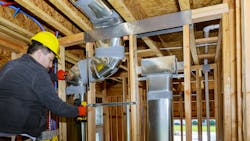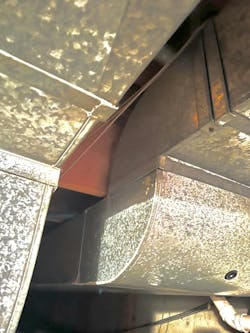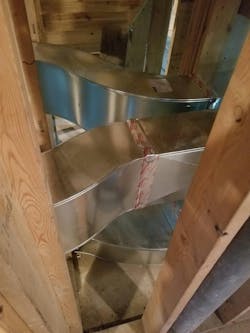Duct Fittings and Comfort: Small Changes Create Large Results
Have you ever considered the assumptions a customer makes about their comfort issues? Putting yourself in someone else's shoes can be challenging, especially when you have insights into what might be happening in their home. You might be the second or third company attempting to fix their problem. In these situations, it's best to zoom out and start with the basics.
A Frustrating First Summer
About six years ago, the Soner family moved into a beautiful, sprawling ranch in a quiet suburb of Chicago. They transformed their home with changes to the flooring, paint colors, and kitchen and bathroom renovations.
Their first summer in their new home was supposed to be perfect. They envisioned lazy afternoons in their spacious living room and peaceful nights in their primary suite. But then the June heat arrived, and their dream turned into an uncomfortable nightmare. No matter how low they set the thermostat, the primary suite remained uncomfortably hot and muggy. It was like sleeping in a different house entirely.
Determined to solve the problem, the Soners called in several local HVAC contractors over the next few years. Each promised a quick fix: an upgraded thermostat here, a minor duct adjustment there. Yet, summer after summer, the same issue persisted. Winters weren’t any better, the primary suite was so bitterly cold that extra blankets and space heaters were a necessity.
For six years, the Soners lived in a home that was “almost perfect.” They became more frustrated as they wondered if they would ever enjoy a comfortable night’s sleep.
Blame the Equipment
The Soners thought an issue with their HVAC equipment could be contributing to their lack of comfort. They got estimates to replace both furnaces and air conditioners because they believed new equipment would resolve their problems. They chose premium equipment and spent nearly $40,000 updating their HVAC systems.
After living with the new equipment, they quickly realized there was almost no improvement to their comfort.
A Call of Desperation
The family called Kat’s Heating and Air Conditioning as a last-ditch effort to fix their issues. Kat’s started with a visual inspection of the duct system for possible defects.
The home had a basement under half of it, and a crawl space underneath the other half. The first-floor elevation was higher on each side of the house but dropped almost a foot in the center. The duct trunkline started in the basement and ran into the crawl space. As it entered the crawl space, it offset down nine inches. The trunk continued another 20 feet and then offset up nine inches to match the floor joist.
The offsets consisted of back-to-back elbows with square throats. According to ACCA Manual D, each offset has an equivalent length of 160 feet of straight duct. That means the two offsets added 320 feet of equivalent straight duct to the system!
The tech from Kat’s installed a test port about 18 inches before the first offset, and another 18 inches after the offset. He adjusted the fan to its highest setting and measured the pressure drop across the fittings. The duct pressure entering the offset was +0.13 inches of water column (in-w.c.), and the duct pressure leaving the offset was +0.065 in-w.c.
The first offset created a pressure drop that was half of the original duct pressure. The second offset was just as bad as the first, leaving almost no pressure for the branch runs at the end of the trunk line. All the supplies that fed the primary suite were the branch runs at the end of the trunk. The primary suite was uncomfortable because of the two major restrictions in the trunkline.
Narrowing the Focus
It would have been easy to sell the Soners a new duct system. But why install all new ducts when 80% of the system performs as intended? There were only two major choke points in the trunk line impacting the supply ducts to the primary suite.
Think of the ducts as a garden hose and the restrictions as a kink in the hose. A kinked garden hose will provide little to no water out of the end. Imagine yourself on a summer morning, going outside to wash your car. You pull the hose towards the driveway and then turn on the water. You quickly realize no water is coming out of the hose. Common sense tells you to find the kink and straighten the hose to allow the water to flow freely. Your first instinct is not to run to the hardware store and buy a new hose. Why do we miss this logic with duct systems?
Anytime you examine airflow problems in a duct system, you need to find the restriction and reduce the pressure drop, allowing the air to flow freely. Kat’s achieved this when they modified the first offset with a round gradual offset called an “ogee.” They could still offset the duct like the original installers, but they selected a much lower equivalent length fitting.
Shorten the Duct
The Kats tech removed the second offset in the crawl space and kept the trunk at the same elevation for the last few duct sections. By eliminating the second offset, Kat’s removed the final trunk duct restriction.
Equivalent lengths can be difficult to understand, so consider the garden hose example again. If you connect a 15-foot hose directly to the water valve and turn it on, you should have good water pressure and flow, provided you have good starting pressure and no kinks in the hose.
Now, imagine you have a long driveway and want to wash your car on the street. To reach your car, you need to connect two 50-foot sections of hose. When you turn on the water valve, you notice the water flow is much less. Why would the water volume change if the water pressure at the house remains the same?
Using a longer hose adds resistance that the water must overcome. Water and air take the path of least resistance, so reducing the duct length (or hose) provides less resistance and an easier path to flow.
Measure Results
If you have ever taken a National Comfort Institute class, you might remember how much we emphasize testing in and testing out. It is important to show the customer you successfully diagnosed and solved their issue.
It can also be beneficial to go one step further and follow up with the customer to measure the job's success. You have not fixed a comfort problem until your customer is truly comfortable.
Remember to follow up with customers a few weeks or months after the job. Ask challenging questions, like “Is there anything we could have done better?” Listen to what they have to say with an open mind. Sometimes, making small changes can create large results.
A Good Night’s Sleep
After making the changes to the duct system, the delivered airflow in the primary suite immediately improved. Kats received a text message from Mrs. Soner the morning after the duct renovation. It was clear that the minor changes to the trunkline were a success. A flow hood or an anemometer can verify a successful job, but there is nothing like receiving unsolicited positive feedback from your customer.
If you’re an HVAC contractor or technician interested in learning more about airflow diagnostics, contact Adam Mufich at ncilink.com/ContactMe. NCI’s website (www.nationalcomfortinstitute.com) is full of free information to help you improve your professionalism and strengthen your company.
About the Author
Adam Mufich
content developer and instructor
Adam Mufich serves the HVAC industry as content developer and instructor for National Comfort Institute, Inc. (NCI). NCI specializes in training that focuses on improving, measuring, and verifying HVAC and Building Performance. Find them at www.nationalcomfortinstitute.com.



